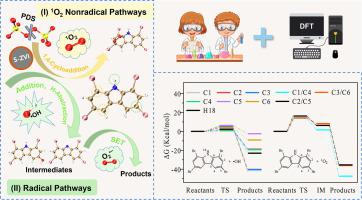Chemical Engineering Journal ( IF 13.3 ) Pub Date : 2023-01-13 , DOI: 10.1016/j.cej.2023.141439 Zhuyu Sun , Luxiang Zhu , Yujia Liu , Yanan Liu , Jin Wen

|
Polyhalogenated carbazoles (PHCZs) are a kind of emerging contaminants which have widespread distribution, strong potential persistence, high bioaccumulation, and dioxin-like toxicity. In this study, we used sulfidated zero-valent iron (S-ZVI) synthesized by ball-milling to activate peroxydisulfate (PDS) for the degradation of 1,3,6,8-tetrabromocarbazole (1,3,6,8-BCZ). The initial 1 mg/L 1,3,6,8-BCZ was degraded by 92.9 % within 30 min in S-ZVI/PDS system. The pseudo-first-order rate constant was estimated as high as 0.182 min−1. Electron paramagnetic resonance (EPR) study and quenching experiments results revealed that •OH, 1O2, O2•−, and SO4•− played roles in the degradation of 1,3,6,8-BCZ, with their contribution percentages of 32.8 %, 32.5 %, 24.8 % and 9.9 %, respectively. By further density functional theory (DFT) calculations, radical addition by •OH and 1,4-cycloaddition by 1O2 were suggested as the dominant channels for 1,3,6,8-BCZ degradation, while O2•− exerted an indirect synergistic influence. Based on the identification of intermediates and analysis of Fukui indices, 1,3,6,8-BCZ degraded through three degradation pathways, namely hydroxylation, debromination, and C–N bond cleavage. The S/Fe molar ratio, S-ZVI dosage, PDS dosage, reaction temperature, initial pH, and water matrices had influences on the degradation in 1,3,6,8-BCZ, result in a great toxicity reduction. Overall, this research developed an effective and feasible approach for the treatment of PHCZs, and which gave deep insights into the vital roles and synergistic effects of various reactive species based on the combination of experimental study and theoretical calculation.
中文翻译:

硫化零价铁活化过二硫酸盐降解 1,3,6,8-四溴咔唑:机理洞察和转化途径
多卤代咔唑(PHCZs)是一类分布广泛、潜在持久性强、生物蓄积性高、具有类二恶英毒性的新兴污染物。在这项研究中,我们使用通过球磨合成的硫化零价铁 (S-ZVI) 来激活过二硫酸盐 (PDS) 以降解 1,3,6,8-四溴咔唑 (1,3,6,8-BCZ) ). 在 S-ZVI/PDS 系统中,初始浓度为 1 mg/L 的 1,3,6,8-BCZ 在 30 分钟内降解了 92.9%。伪一级速率常数估计高达 0.182 min -1。电子顺磁共振(EPR)研究和猝灭实验结果显示•OH、1 O 2、O 2 •−和SO 4 •−对1,3,6,8-BCZ的降解起一定作用,贡献率分别为32.8%、32.5%、24.8%和9.9%。通过进一步的密度泛函理论 (DFT) 计算,•OH 的自由基加成和1 O 2的 1,4-环加成被认为是 1,3,6,8-BCZ 降解的主要通道,而 O 2 •−发挥了间接的协同作用。基于中间体的鉴定和福井指数分析,1,3,6,8-BCZ通过3种降解途径降解,即羟基化、脱溴和C-N键断裂。S/Fe 摩尔比、S-ZVI 用量、PDS 用量、反应温度、初始 pH 值和水基质对 1,3,6,8-BCZ 的降解有影响,导致毒性大大降低。总的来说,本研究开发了一种有效且可行的治疗 PHCZ 的方法,并在实验研究和理论计算相结合的基础上深入了解了各种活性物质的重要作用和协同效应。






























 京公网安备 11010802027423号
京公网安备 11010802027423号